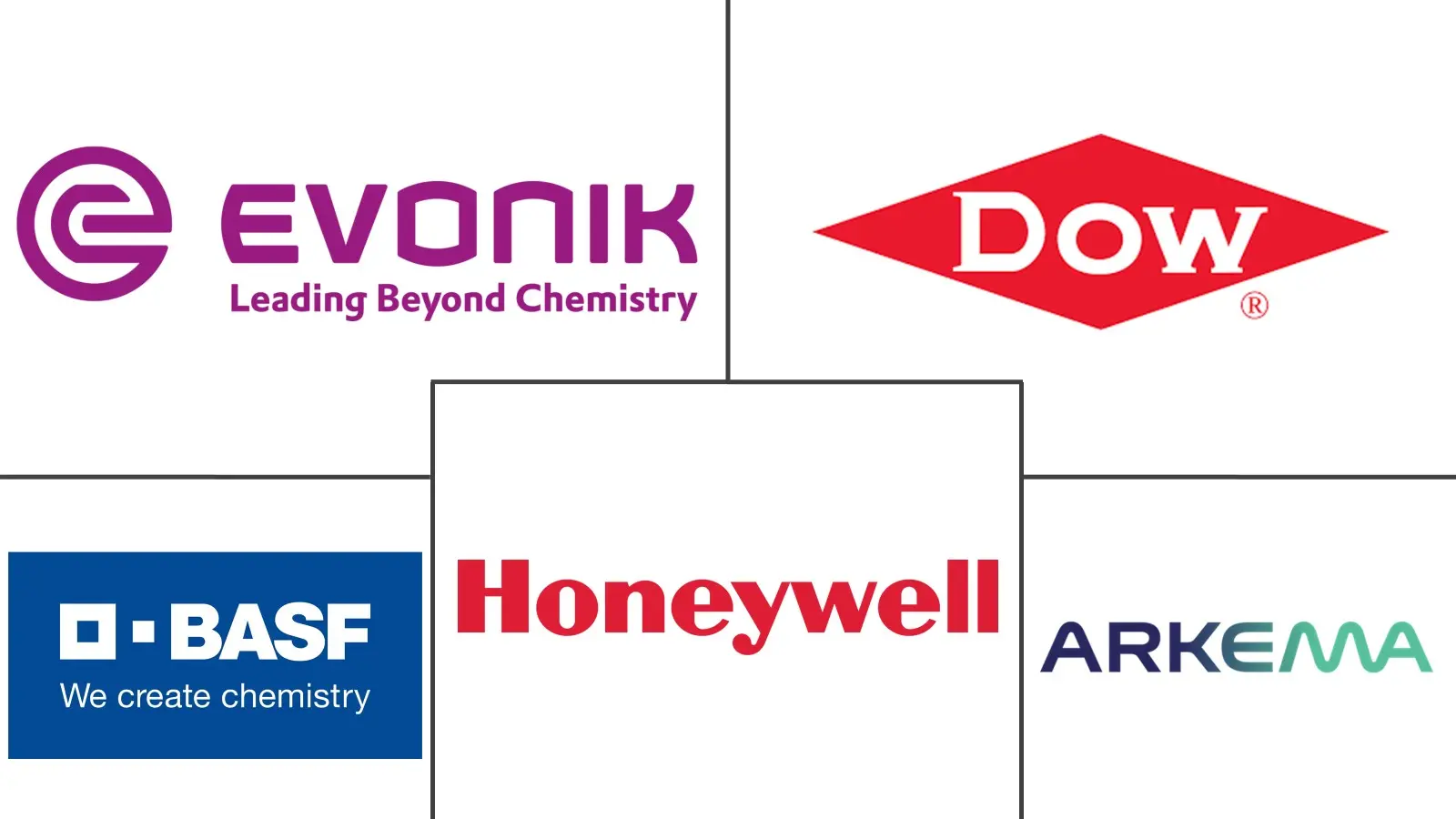Formulation Additive Market Size and Share
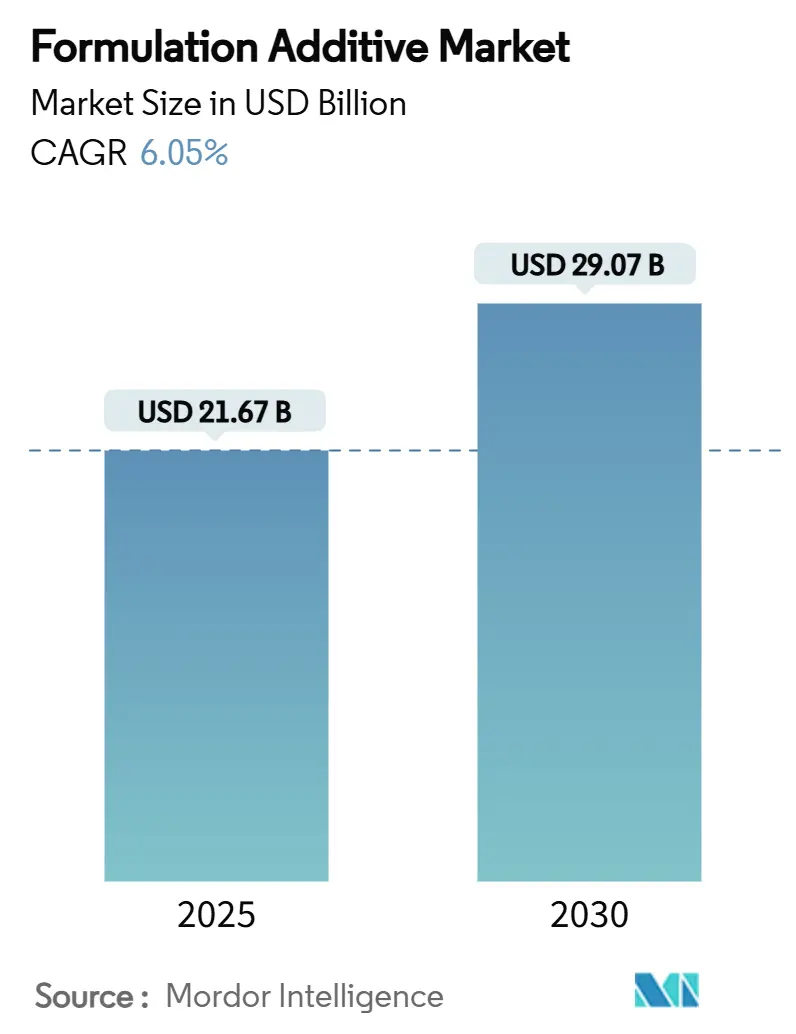
Formulation Additive Market Analysis by Mordor Intelligence
The Formulation Additive Market size is estimated at USD 21.67 Billion in 2025, and is expected to reach USD 29.07 Billion by 2030, at a CAGR of 6.05% during the forecast period (2025-2030). Steady growth rests on regulatory mandates favoring low-VOC (Volatile Organic Compound) chemistries, public-sector infrastructure spending across emerging economies, and rapid material innovation that improves the performance of lightweight composites and e-mobility fluids. Suppliers with robust research and development (R&D) programs and vertically integrated feedstock supply continue to outpace the broader field, while newcomers focused on bio-based portfolios capture share in niche, high-margin segments. Asia-Pacific remains pivotal, contributing more than 40% of global revenue and recording the fastest regional gains, yet North America and Europe provide premium opportunities linked to stringent sustainability standards. Volatile petrochemical prices and higher compliance costs under REACH (Registration, Evaluation, Authorization and Restriction of Chemicals) and TSCA (Toxic Substances Control Act) temper near-term margin expansion but simultaneously accelerate the transition to cost-stable, plant-derived raw materials.
Key Report Takeaways
- By additive type, dispersing agents commanded 33.67% of the Formulation Additive market share in 2024; rheology modifiers are on track for a 6.56% CAGR to 2030.
- By end-use industry, construction captured 28.66% of the Formulation Additive market size in 2024, whereas electronics is projected to grow at 6.87% CAGR through 2030.
- By formulation technology, solvent-borne systems retained 46.44% share of the Formulation Additive market size in 2024, while UV/EB-curable systems are forecast to rise at a 7.24% CAGR during 2025-2030.
- By geography, Asia-Pacific held 42.16% of the formulation additive market share in 2024, and the region is anticipated to post a 6.97% CAGR to 2030.
Global Formulation Additive Market Trends and Insights
Drivers Impact Analysis
| Driver | (~) % Impact on CAGR Forecast | Geographic Relevance | Impact Timeline |
|---|---|---|---|
| Sustainability-driven Switch to Low-VOC Water-borne Coatings | +1.2% | Global, stronger in EU and North America | Medium term (2-4 years) |
| Expansion of Infrastructure Spending in Emerging Economies | +1.8% | APAC core; spill-over to Middle East and Latin America | Long term (≥4 years) |
| Rapid Growth of High-performance Lightweight Composites | +0.9% | North America and EU aerospace; APAC automotive | Medium term (2-4 years) |
| E-mobility Demand for Thermal-management Fluids and Additives | +0.7% | Global, with China and EU early adoption | Short term (≤2 years) |
| Bio-based Multifunctional Additives Gaining OEM Approvals | +0.6% | EU and North America; expanding to APAC | Long term (≥4 years) |
| Source: Mordor Intelligence | |||
Sustainability-driven Switch to Low-VOC Water-borne Coatings
Regulators now insist on quantifiable carbon-footprint reductions, propelling a structural shift from solvent-borne to water-borne platforms. BASF launched ISCC+ certified acrylics offering up to 40% bio-content and a 30% lower cradle-to-gate carbon profile [1]BASF News Release, “BASF transitions to ISCC+ certified Ethyl Acrylate,” basf.com. Water-borne systems need bespoke rheology modifiers and dispersants that stabilize pigments without volatile organics, which rewards suppliers fluent in advanced polymer architecture. Total raw-material expense can fall by 15% compared with solvent-borne analogs, further improving user economics. Clariant broadened its PFAS-free AddWorks and Licocare lines to meet new European product safety standards. R&D intensity is rising because customers seek plug-and-play solutions that match legacy performance while clearing ever-tighter VOC limits.
Expansion of Infrastructure Spending in Emerging Economies
Fast-growing cities in China, India, and Indonesia require long-life roads, bridges, and housing, which boosts demand for durable coatings, sealants, and concrete-enhancing agents. Sika reported 12.8% top-line expansion in local currencies during H1 2024 and opened new factories in Peru and China to service construction-grade additives. Governments mandate higher resilience against moisture, UV, and microbial attack, elevating the need for multifunctional additive packages. Dow deepened its construction silicones distribution alliance with Univar, strengthening last-mile supply across Central and Eastern Europe. Fire-retardant specifications increasingly favor bio-based inputs; ALTANA invested in NORDTREAT’s plant-derived flame-retardant technology, signaling wider acceptance of renewable feedstocks.
Rapid Growth of High-performance Lightweight Composites
Weight-sensitive sectors such as aerospace, wind energy, and premium automotive accelerate the uptake of carbon-fiber and glass-fiber composites. Oak Ridge National Laboratory demonstrated carbon-nanofiber additives that raise composite tensile strength by 50% and toughness by nearly 100%. Dow scaled International Sustainability and Carbon Certification (ISCC)+ certified NORDEL REN EPDM rubbers that deliver identical mechanical integrity while lowering life-cycle emissions. Nanomaterial dispersants improve fiber-matrix adhesion, allowing thinner laminates that cut mass without compromising crash performance. Graphene-enhanced epoxy showed a 177% gain in tensile strength in peer-reviewed trials. Additive-assisted automated lay-up and 3-D printing shrink cycle times and reduce scrap, reinforcing demand for formulation expertise that stabilizes resins throughout digital production flows.
E-mobility Demand for Thermal-management Fluids and Additives
Fast-charging battery platforms require immersion or direct-contact coolants with high dielectric strength and superior thermal conductivity. Castrol’s ON e-thermal fluid lowered peak cell temperatures by 28°C and enabled 41% quicker charging versus water-glycol systems. China’s GB29743.2 regulation caps electrical conductivity in EV coolants, urging formulators to redesign additive packages that balance viscosity, oxidation stability, and safety. TotalEnergies advanced a water-based super-lubricant that cuts environmental impact by 30% while preserving tribological performance. Lubrizol commercialized immersion-cooling fluids engineered to mitigate thermal runaway, ushering in a new class of additives drawn from dielectric ester chemistry. Accelerated model cycles among battery Original Equipment Manufacturers (OEMs) guarantee continuous refresh of fluid specifications, sustaining an innovation flywheel for specialty additive suppliers.
Restraints Impact Analysis
| Restraint | (~) % Impact on CAGR Forecast | Geographic Relevance | Impact Timeline |
|---|---|---|---|
| Volatile petrochemical feedstock pricing | -1.1% | Global, with Asia-Pacific most affected | Short term (≤2 years) |
| Stringent REACH and TSCA re-registration costs | -0.8% | EU and North America, expanding globally | Medium term (2-4 years) |
| Rising PFAS-free specification bans | -0.7% | Global, with EU and North America leading | Medium term (2-4 years) |
| Source: Mordor Intelligence | |||
Volatile Petrochemical Feedstock Pricing
Crackers in Southeast Asia extended shutdowns into early 2025 as ethylene and propylene spreads remained below cash costs, constraining regional supply and inflating spot quotes. Argus projected polymer-grade propylene in the United States to rise by 5 cents per pound by mid-2025 after LyondellBasell’s refinery exit removed a key on-purpose feed source. Producers now test bio-naphtha and pyrolysis oil blends, yet capital intensity and certification hurdles delay widespread adoption. Overcapacity in new Middle East mega-complexes perpetuates pricing volatility because incremental output struggles to secure long-term contracts. Formulators hedge with dual-sourcing strategies and incremental bio-content, though margin recovery remains susceptible to geopolitical events that disrupt trade lanes.
Stringent REACH and TSCA Re-registration Costs
The US Environmental Protection Agency quadrupled many Toxic Substances Control Act fees in April 2024, pushing aggregate annual compliance outlays for chemical manufacturers beyond USD 146 million [2]US EPA, “Revised TSCA fee rule effective April 2024,” epa.gov. Parallel to US changes, the European Commission’s proposed PFAS phase-out and stricter essential-use tests trigger widespread reformulation in fluorinated surfactants and anti-foam agents. Estimates put PFAS remediation costs at USD 3 billion per year for water utilities alone, forcing value-chain actors to internalize greater liability risk. Larger conglomerates absorb audit, testing, and dossier fees through centralized regulatory teams, yet small and midsize firms face rising entry barriers and possible portfolio pruning. The timely adoption of non-fluorinated chemistry now functions as risk mitigation and brand differentiator.
Segment Analysis
By Additive Type: Dispersing Agents Consolidate Leadership
Dispersing agents generated the largest slice of the formulation additive market in 2024, holding 33.67% of revenue on the back of constant demand across pigments, fillers, and carbon-black masterbatches. Rheology modifiers follow as the fastest-advancing niche, supported by a 6.56% CAGR that reflects the rapid switch to water-borne chemistries where viscosity control governs film uniformity. Lubrizol’s Solsperse W60 hyper-dispersant illustrates how 90% active-matter formulations shrink dosage by 15% and eliminate alkylphenol ethoxylates, creating a lower-toxicity profile. BASF expanded its Rheovis range with non-ionic associative thickeners that provide pseudoplastic flow, allowing sprayable yet sag-free coatings. Defoamers remain stable given broad industrial use, but silicone-free grades grow faster within food packaging and inkjet graphic arts.
The segment’s technical agenda now centers on multifunctional polymers able to disperse, wet, and control foam in a single backbone, which trims SKU count for downstream mixers. Nanoparticle compatibilizers that couple pigments to water-borne polyurethane matrices attract additional R&D as printing applications lean toward ever-finer nib widths. Suppliers anticipate that hybrid organic-inorganic scaffolds will underpin the next wave of performance gains, unlocking lower pigment loadings without color-strength loss and cutting overall formulation costs.
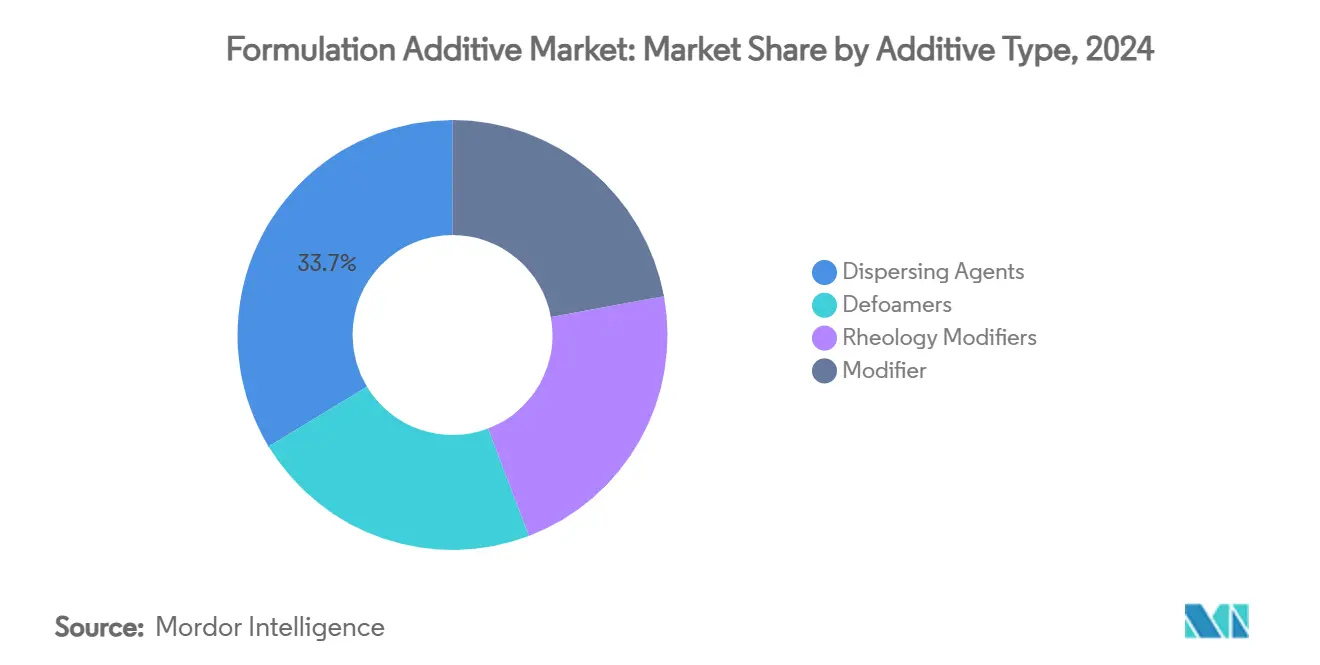
Note: Segment shares of all individual segments available upon report purchase
By End-use Industry: Construction Maintains Dominance, Electronics Accelerates
Construction captured 28.66% of the formulation additive market size in 2024, propelled by transport corridors, affordable housing, and resilient public infrastructure programs. High-alumina anti-corrosion dispersions and hydrophobic rheology modifiers register sustained pull as engineers specify longer design life. ALTANA’s investment in NORDTREAT flame-retardant bio-chemistry underlines the shift toward greener fire safety solutions. Electronics meanwhile charts a 6.87% CAGR as chip-makers order ultra-pure defoamers and extreme-temperature wetting agents for advanced lithography processes. The printed-sensor sub-segment alone is forecast to exceed USD 15 Billion by 2030, creating additional tailwinds.
Transportation and automotive segments add steady mid-single-digit growth grounded in lightweighting and battery-thermal demands. Oil and gas retain specialized requirements for friction reducers in drilling fluids. Food and beverage formulations experience stricter regulatory oversight, prompting per- and polyfluoroalkyl substances (PFAS)-free direct-food-contact barriers. Across industries, the migration to bio-content and low VOC pushes R&D investment toward plant-derived feedstocks that match incumbent performance in challenging service environments.
By Formulation Technology: UV/EB Systems Challenge Solvent-borne Incumbency
Solvent-borne platforms still account for 46.44% of total revenue, given their track record in harsh industrial settings. Nevertheless, UV/EB-curable chemistries lead growth at a 7.24% CAGR, favored for instant curing, lower energy draw, and negligible VOC. Research on thiol-ene click reactions extends UV cure to water-borne polyurethane dispersions, opening fresh territory in flooring and flexible packaging applications. Powder coatings remain a niche for metal furniture and appliance shells but gain acceptance in EV battery enclosures where outgassing constraints exclude liquid paints. Clariant launched Ceridust Vita waxes that align with perfluorooctanoic acid (PFOA) restrictions and boost scratch resistance in powder formulations.
Water-borne systems climb steadily, helped by ongoing capital expenditure in high-shear dispersion equipment that eliminates microfoam. Suppliers integrate digital rheology models to optimize flow curves, reducing lab iterations. Solvent-free hot-melt adhesives extend reach into protective films for consumer electronics, signaling a broader market redirection toward low-emission chemistries.

Note: Segment shares of all individual segments available upon report purchase
Geography Analysis
Asia-Pacific generated the largest revenue pool in 2024 at 42.16% and projects the sharpest uptick to 2030 with a 6.97% CAGR, reflecting the region’s manufacturing and civil engineering dominance. China sustains double-digit demand for construction sealants and electric-vehicle thermal fluids, supported by extensive domestic feedstock integration. India elevates public capital expenditure under its National Infrastructure Pipeline, translating into long contracts for concrete admixtures and exterior protective coatings. Southeast Asian nations scale semiconductor back-end capacity, opening channels for electronics-grade dispersants that meet stringent ionic-contamination ceilings.
North America benefits from robust aerospace and private housing investments, plus abundant shale-based feedstocks that cushion cost spikes. The Inflation Reduction Act accelerates solar and battery gigafactory construction, spurring local sourcing of UV-curable resins and dielectric coolants. European output mirrors regulatory leadership; REACH enforcement and circular-economy directives encourage early adoption of mass-balance and mechanically recycled raw-material inputs. Germany and France allocate public grants to upgrade rail and bridge assets, supporting anti-corrosion additive offtake.
Latin America offers pockets of upside in Chilean copper mines and Brazilian agrochemical packaging, though currency volatility restrains faster scale-up. Middle East and Africa see infrastructure investment linked to logistics corridors such as the African Continental Free Trade Area and Gulf smart-city projects, favoring cement-compatible rheology modifiers and temperature-stable dispersants. Multinational suppliers increasingly license technology to regional compounders, balancing intellectual-property protection with localized production to sidestep import tariffs and shipping delays.
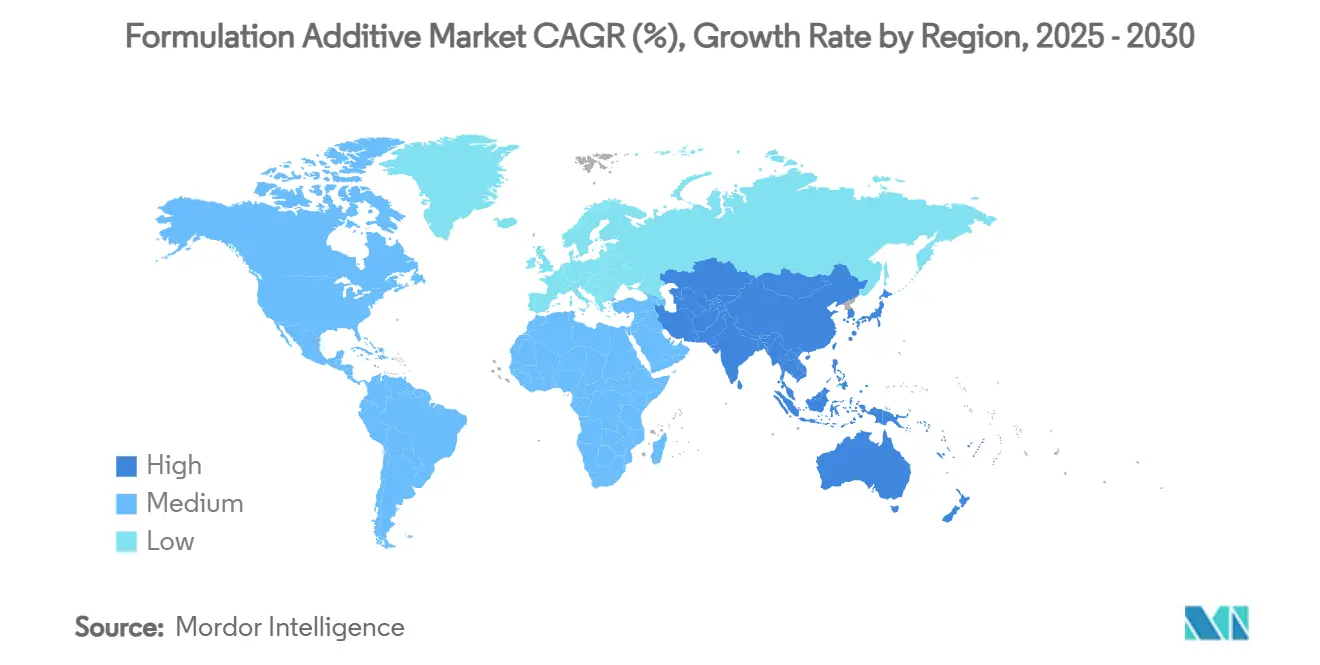
Competitive Landscape
The Formulation Additive market is moderately consolidated with the presence of major players, including BASF, Dow, Evonik Industries AG, Arkema, and Honeywell International Inc. These companies possess global plants, backward-integrated monomer access, and annual R&D budgets exceeding USD 400 Million each. BASF’s coatings unit generated USD 4.3 Billion in 2024, underscoring scale advantages that fund rapid substitution programs for low-carbon offerings. ALTANA reported EUR 3.17 Billion in revenue, a 16% increase supported by its BYK additives franchise. Digital platforms sharpen competitive edges: Dow’s Paint Vision software trims formulation cycles by 48% using machine-learning algorithms, while BASF’s D’lite suite guides customers toward lower cradle-to-gate emissions. Smaller specialists leverage bio-based portfolios to secure premium contracts, often in partnership with tier-one OEMs eager to meet Scope 3 emissions targets. Licensing frameworks and tolling agreements enable asset-light players to scale without heavy capital commitments.
Formulation Additive Industry Leaders
-
Dow
-
Honeywell International Inc.
-
BASF
-
Evonik Industries AG
-
Arkema
- *Disclaimer: Major Players sorted in no particular order
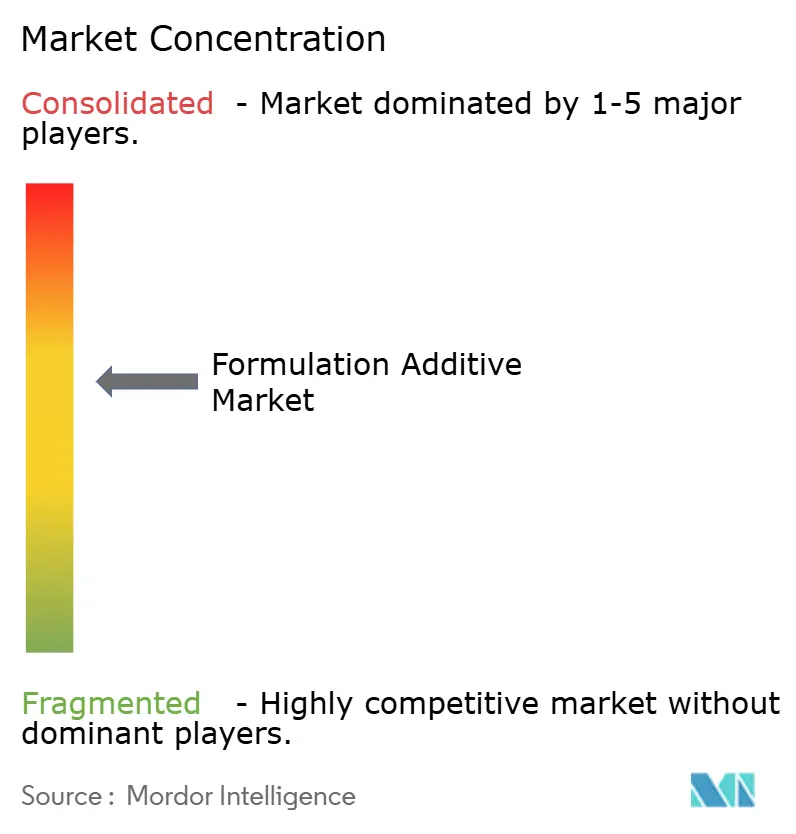


Recent Industry Developments
- April 2025: Evonik Coating Additives, a subsidiary of Evonik Industries AG developed TEGO Wet 288, a substrate wetting formulation additive for waterborne and radiation-cured formulations. Furthermore, the additive has broad food contact compliance, making it suitable for food packaging applications.
- February 2025: Arxada launched Polyboost, a multifunctional additive developed to enhance a wide range of paint and coating properties. This formulation additive improves the stability of pH and viscosity of paint formulations and supports low preservative use rates, which may avoid an H317 hazard label.
Global Formulation Additive Market Report Scope
The scope of the formulation additive market report includes:
| Defoamers |
| Rheology Modifiers |
| Modifier |
| Dispersing Agents |
| Construction |
| Transportation |
| Automotive |
| Oil and Gas |
| Food and Beverage |
| Electronics |
| Other End-user Industries |
| Water-borne Systems |
| Solvent-borne Systems |
| Powder Coatings |
| UV/EB-curable Systems |
| Asia-Pacific | China |
| Japan | |
| India | |
| South Korea | |
| Rest of Asia-Pacific | |
| North America | United States |
| Canada | |
| Mexico | |
| Europe | Germany |
| United Kingdom | |
| France | |
| Italy | |
| Rest of Europe | |
| South America | Brazil |
| Argentina | |
| Rest of South America | |
| Middle East and Africa | Saudi Arabia |
| South Africa | |
| Rest of Middle East and Africa |
| By Additive Type | Defoamers | |
| Rheology Modifiers | ||
| Modifier | ||
| Dispersing Agents | ||
| By End-use Industry | Construction | |
| Transportation | ||
| Automotive | ||
| Oil and Gas | ||
| Food and Beverage | ||
| Electronics | ||
| Other End-user Industries | ||
| By Formulation Technology | Water-borne Systems | |
| Solvent-borne Systems | ||
| Powder Coatings | ||
| UV/EB-curable Systems | ||
| By Geography | Asia-Pacific | China |
| Japan | ||
| India | ||
| South Korea | ||
| Rest of Asia-Pacific | ||
| North America | United States | |
| Canada | ||
| Mexico | ||
| Europe | Germany | |
| United Kingdom | ||
| France | ||
| Italy | ||
| Rest of Europe | ||
| South America | Brazil | |
| Argentina | ||
| Rest of South America | ||
| Middle East and Africa | Saudi Arabia | |
| South Africa | ||
| Rest of Middle East and Africa | ||


Key Questions Answered in the Report
What is the current value of the Formulation Additive market?
The Formulation Additive market size reached USD 21.67 Billion in 2025.
How fast is the sector expected to grow to 2030?
The market is forecast to expand at a 6.05% CAGR, rising to USD 29.07 Billion by 2030.
Which additive type holds the largest revenue share?
Dispersing agents led with 33.67% of global revenue in 2024.
Which downstream industry is expanding the quickest?
Electronics applications are projected to post a 6.87% CAGR through 2030 due to semiconductor complexity.
Why is Asia-Pacific so important?
Asia-Pacific accounted for 42.16% of revenue in 2024 and is set to grow at a 6.97% CAGR thanks to manufacturing scale and infrastructure build-out.
Page last updated on:
